
Nothofagus, also known as the southern beeches, is a genus of 43 species of trees and shrubs native to the Southern Hemisphere in southern South America and Australasia. The species are ecological dominants in many temperate forests in these regions. Some species are reportedly naturalised in Germany and Great Britain. The genus has a rich fossil record of leaves, cupules, and pollen, with fossils extending into the late Cretaceous period and occurring in Australia, New Zealand, Antarctica, and South America.

Myosotis is a genus of flowering plants in the family Boraginaceae. The name comes from the Ancient Greek μυοσωτίς "mouse's ear", which the foliage is thought to resemble. In the northern hemisphere they are colloquially denominated forget-me-nots or scorpion grasses. The colloquial name "forget-me-not" was calqued from the German Vergissmeinnicht and first used in English in AD 1398 through King Henry IV of England. Similar names and variations are found in many languages. Myosotis alpestris is the official flower of Alaska and Dalsland, Sweden. Plants of the genus are commonly confused with Chatham Islands' forget-me-nots which belong to the related genus Myosotidium.

Coprosma is a genus of flowering plants in the family Rubiaceae. It is found in New Zealand, Hawaiian Islands, Borneo, Java, New Guinea, islands of the Pacific Ocean to Australia and the Juan Fernández Islands.
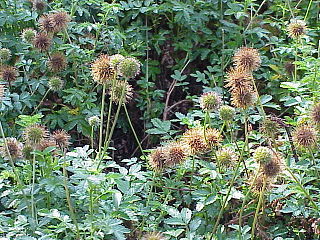
Acaena is a genus of about 60 species of mainly evergreen, creeping herbaceous perennial plants and subshrubs in the family Rosaceae, native mainly to the Southern Hemisphere, notably New Zealand, Australia and South America, but with a few species extending into the Northern Hemisphere, north to Hawaii and California.

Cordyline is a genus of about 15 species of woody monocotyledonous flowering plants in family Asparagaceae, subfamily Lomandroideae. The subfamily has previously been treated as a separate family Laxmanniaceae, or Lomandraceae. Other authors have placed the genus in the Agavaceae. Cordyline is native to the western Pacific Ocean region, from New Zealand, eastern Australia, southeastern Asia and Polynesia, with one species found in southeastern South America.
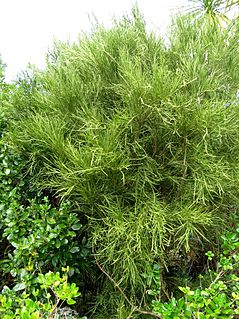
Carmichaelia is a genus of 24 plant species belonging to Fabaceae, the legume family. All but one species are native to New Zealand; the exception, Carmichaelia exsul, is native to Lord Howe Island and presumably dispersed there from New Zealand.

Dracophyllum is a genus of plants belonging to the family Ericaceae, formerly Epacridaceae. There are 61 species in the genus, mostly shrubs, but also cushion plants and trees, found in New Zealand, Australia, Lord Howe Island and New Caledonia. The name Dracophyllum, meaning dragon-leaf, refers to their strong outward similarity to the unrelated Dracaena, sometimes known as dragon tree. Although dicotyledonous, they resemble primitive monocots with their slender leaves concentrated in clumps at the ends of the branches; they are sometimes called grass-trees.
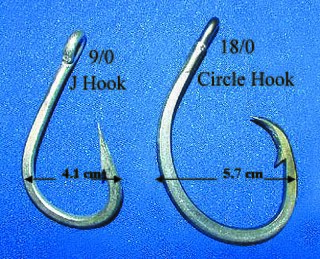
A circle hook is a type of fish hook which is sharply curved back in a circular shape. It has become widely used among anglers in recent years because the hook generally catches more fish and is rarely swallowed. Since the circle hook catches the fish on the lips at the corner of its mouth, it usually decreases the mortality rates of released fish as compared to J-hook which are often swallowed by the fish, causing damage to the gills or vital organs. The circle hook's shape allows it to only hook onto an exposed surface, which in the case of a fish means the corner of its mouth. The fish takes the baited hook and swallows it, and as the hook is reeled in, it is safely pulled out of the fish until it reaches the mouth. At this point it will catch the corner of the mouth, resulting in fewer gut-hooked fish.

Celmisia is a genus of perennial herbs or subshrubs, in the sunflower family. Most of the species are endemic to New Zealand; several others are endemic to Australia.

Brachyglottis is a genus of flowering plants in the family Asteraceae. The genus was erected on November 29, 1775, by Johann Reinhold Forster and Georg Forster. The name was derived from the Greek brachus ("short") and glottis a reference to the size of the ray florets.
Rostkovia is a genus of plant in family Juncaceae described as a genus in 1809.

Chionochloa is a genus of tussock grass in the family Poaceae, found primarily in New Zealand with one known species in New Guinea and another on Lord Howe Island. Some of the species are referred to as snowgrass.
Étienne Fiacre Louis Raoul was a French naval surgeon and naturalist.

The colossal squid is part of the family Cranchiidae. It is sometimes called the Antarctic squid or giant cranch squid and is believed to be the largest squid species in terms of mass. It is the only recognized member of the genus Mesonychoteuthis and is known from only a small number of specimens. The species is confirmed to reach a mass of at least 495 kilograms (1,091 lb), though the largest specimens—known only from beaks found in sperm whale stomachs—may perhaps weigh as much as 600–700 kilograms (1,300–1,500 lb), making it the largest-known invertebrate. Maximum total length has been estimated at 9–10 metres (30–33 ft).
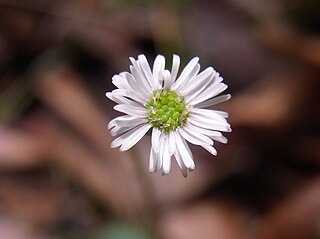
Lagenophora is a genus of flowering plants in the sunflower family. Species occur in South-east Asia, Australia, New Zealand, as well as Central and South America.
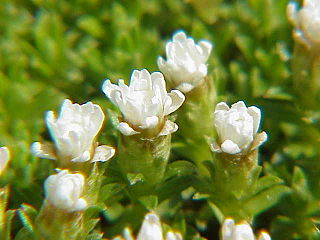
Raoulia is a genus of New Zealand plants in the pussy's-toes tribe within the daisy family.

Elsie Low, was a New Zealand botanist, teacher and temperance campaigner.
Argyrotegium is a genus of plants in the sunflower family, native to Australia and New Zealand.
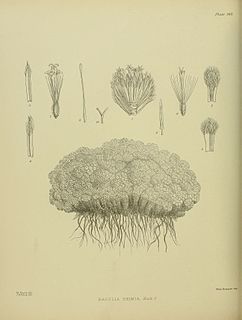
Raoulia eximia is a species of plant in the aster family. It was first formally described in 1864 by Joseph Dalton Hooker. It is endemic to New Zealand. The plant is commonly known by its Māori name tutāhuna and as the true vegetable sheep, suggesting its appearance at a distance resembling a sheep.

Raoulia australis, the scabweed or scab plant, is a species of flowering plant in the family Asteraceae, native to New Zealand. It is used as a ground cover.

















